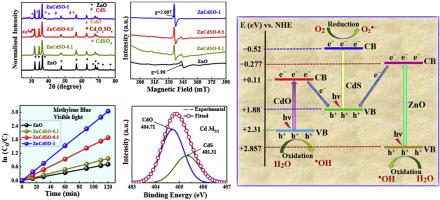当前位置:
X-MOL 学术
›
Sol. Energy Mater. Sol. Cells
›
论文详情
Our official English website, www.x-mol.net, welcomes your
feedback! (Note: you will need to create a separate account there.)
Ternary ZnCdSO composite photocatalyst for efficient dye degradation under visible light retaining Z-scheme of migration pathways for the photogenerated charge carriers
Solar Energy Materials and Solar Cells ( IF 6.3 ) Pub Date : 2020-11-01 , DOI: 10.1016/j.solmat.2020.110674 Debajyoti Das , Prami Nandi
Solar Energy Materials and Solar Cells ( IF 6.3 ) Pub Date : 2020-11-01 , DOI: 10.1016/j.solmat.2020.110674 Debajyoti Das , Prami Nandi

|
Abstract Simple co-precipitation method followed by calcination was adopted to synthesize ZnCdSO ternary semiconductor photocatalyst. In the composite material highly crystalline and hexagonal wurtzite phase of ZnO along with hexagonal CdS and cubic CdO phases were separately identified. Oxygen vacancies (VO) in ZnO network and CdO phase resulted in narrowing the optical band gap, facilitating increased visible light absorption. CdS–CdO phase mediated surface defects increased significantly over the core/bulk defects in pristine ZnO, which simultaneously acted as trap-sites for charge carriers and active adsorption-sites for dyes for photocatalytic degradation. In photocatalytic Z-scheme charge transfer mechanism CdS with a higher negative potential conduction band acted as efficient reduction site and created superoxide radical anions (O2•−), whereas ZnO and CdO both having lower valence band potential acted as efficient oxidation sites and created hydroxyl radicals (•OH). Spatial separation of photo-generated charge carriers enhanced their lifetime and facilitated creating superoxide and hydroxyl radicals which, by virtue of their powerful and respective reducing and oxidizing properties, efficiently degraded the dye molecules. The hydroxyl radicals (•OH) and holes (h+) dominantly contributed in sequence, in the dye degradation process, while electrons (e−) and superoxide radicals (O2•−) had gradually lesser inputs to the phenomenon, as evidently identified via radical scavenging experiment with optical absorption study. Thus, photoactive ternary ZnO–CdS–CdO composite, produced via formation of CdO phase upon low temperature (300 °C) calcination, offered a significantly photostable superior photocatalyst for efficient dye degradation under visible light via a double Z-scheme charge transfer mechanism.
中文翻译:

三元ZnCdSO复合光催化剂用于在可见光下有效降解染料,保留光生载流子迁移途径的Z-scheme
摘要 采用简单的共沉淀法和煅烧法合成了ZnCdSO三元半导体光催化剂。在复合材料中,ZnO 的高度结晶和六方纤锌矿相以及六方 CdS 和立方 CdO 相被分别识别。ZnO 网络和 CdO 相中的氧空位 (VO) 导致光学带隙变窄,有助于增加可见光吸收。CdS-CdO 相介导的表面缺陷比原始 ZnO 的核/体缺陷显着增加,同时充当电荷载流子的陷阱位点和染料的活性吸附位点,用于光催化降解。在光催化 Z 型电荷转移机制中,具有较高负电势导带的 CdS 作为有效还原位点并产生超氧自由基阴离子 (O2•−),而具有较低价带电位的 ZnO 和 CdO 作为有效的氧化位点并产生羟基自由基 (•OH)。光生电荷载流子的空间分离提高了它们的寿命,并促进了超氧化物和羟基自由基的产生,凭借其强大的各自的还原和氧化特性,有效地降解了染料分子。在染料降解过程中,羟基自由基 (•OH) 和空穴 (h+) 依次占主导地位,而电子 (e-) 和超氧自由基 (O2•-) 对该现象的输入逐渐减少,这显然是通过自由基确定的具有光吸收研究的清除实验。因此,光敏三元 ZnO-CdS-CdO 复合材料,通过在低温 (300 °C) 煅烧时形成 CdO 相而产生,
更新日期:2020-11-01
中文翻译:

三元ZnCdSO复合光催化剂用于在可见光下有效降解染料,保留光生载流子迁移途径的Z-scheme
摘要 采用简单的共沉淀法和煅烧法合成了ZnCdSO三元半导体光催化剂。在复合材料中,ZnO 的高度结晶和六方纤锌矿相以及六方 CdS 和立方 CdO 相被分别识别。ZnO 网络和 CdO 相中的氧空位 (VO) 导致光学带隙变窄,有助于增加可见光吸收。CdS-CdO 相介导的表面缺陷比原始 ZnO 的核/体缺陷显着增加,同时充当电荷载流子的陷阱位点和染料的活性吸附位点,用于光催化降解。在光催化 Z 型电荷转移机制中,具有较高负电势导带的 CdS 作为有效还原位点并产生超氧自由基阴离子 (O2•−),而具有较低价带电位的 ZnO 和 CdO 作为有效的氧化位点并产生羟基自由基 (•OH)。光生电荷载流子的空间分离提高了它们的寿命,并促进了超氧化物和羟基自由基的产生,凭借其强大的各自的还原和氧化特性,有效地降解了染料分子。在染料降解过程中,羟基自由基 (•OH) 和空穴 (h+) 依次占主导地位,而电子 (e-) 和超氧自由基 (O2•-) 对该现象的输入逐渐减少,这显然是通过自由基确定的具有光吸收研究的清除实验。因此,光敏三元 ZnO-CdS-CdO 复合材料,通过在低温 (300 °C) 煅烧时形成 CdO 相而产生,











































 京公网安备 11010802027423号
京公网安备 11010802027423号